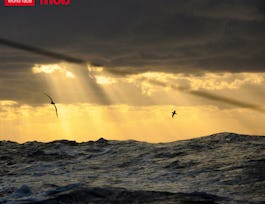Learn how aeroecology, a discipline that studies airborne life forms, has been revolutionised with the use of radar with this unique course. This course is designed to help scientists, researchers as well as ecology enthusiasts to develop skills in using radar to explore biodiversity.



Aeroecology: Exploring Biodiversity with Radar

Instructor: Christopher Hassall
Sponsored by PTT Global Chemical
Recommended experience
What you'll learn
Learn the principles of radar and how radar data can tell us about the diversity and abundance of organisms.
Explore how to apply radar to provide novel approaches to the study of complex questions in biodiversity research.
Details to know

Add to your LinkedIn profile
6 assignments
See how employees at top companies are mastering in-demand skills


Earn a career certificate
Add this credential to your LinkedIn profile, resume, or CV
Share it on social media and in your performance review

There are 2 modules in this course
This first week of content will give you a basic understanding of radar science and biodiversity science. At the end of the week, we will bring the two research areas together and consider how they can inform one another. In the second week, we will explore the more technical aspects of radar aeroecology. We will look at the important and neglected questions that radar can address in biodiversity science, and how radar data can complement other sources of information about the natural world. You will end week 2 with an opportunity to generate your own research idea that builds on your new understanding.
What's included
8 videos11 readings3 assignments5 discussion prompts
Welcome to week two of this course on Aeroecology: exploring biodiversity with radar. In week one of the course, you were introduced to the fundamentals of radar science and biodiversity research, then we brought the two together to explore how the two disciplines can work together to generate biological information from radar data. Week two will develop that initial overview to examine some of the key gaps in our understanding of ecosystems. We will start by looking at how we measure abundance in biodiversity research, and why this is important in an ecological context. We will then move on to look at the importance of measuring diversity, and the extent to which radar is able to do so. I will illustrate these abundance and diversity topics with a range of case studies to show you how radar is currently being applied in some areas. In the final part of the course, we will take a step back and survey the field for future opportunities. The optional assessment involves you as learners becoming practitioners yourselves and exploring these opportunities to find a research area that might be of interest to you.
What's included
7 videos9 readings3 assignments1 peer review1 discussion prompt
Instructor

Offered by
Why people choose Coursera for their career




Recommended if you're interested in Physical Science and Engineering

Banco Interamericano de Desarrollo

Universitat de Barcelona

Splunk Inc.

University of Illinois Urbana-Champaign

Open new doors with Coursera Plus
Unlimited access to 10,000+ world-class courses, hands-on projects, and job-ready certificate programs - all included in your subscription
Advance your career with an online degree
Earn a degree from world-class universities - 100% online
Join over 3,400 global companies that choose Coursera for Business
Upskill your employees to excel in the digital economy


